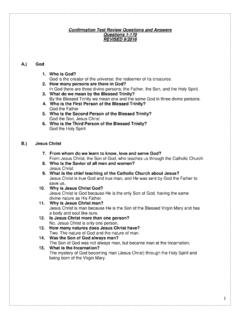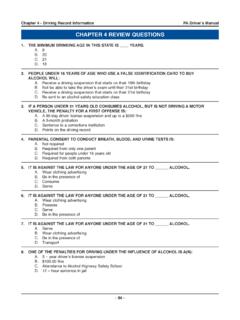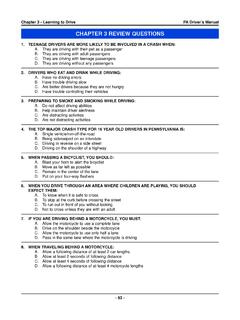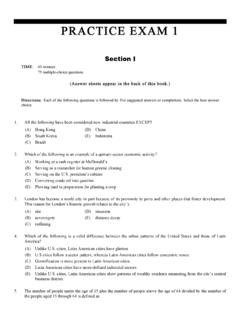Transcription of Exam #2 Review Questions (Answers) ECNS 303 - D. Mark …
1 Exam #2 Review Questions ( answers ). ecns 303 . Exam #2 will cover all the material we have covered since Exam #1. This includes the material we covered in Chapters 10, 11, 12, and 14. In addition to working these problems, I would recommend reviewing all of your old class notes and quizzes, the answers to which are posted on our webpage. 1.) Recall the quantity theory of money. Suppose the Fed reduces the money supply and assume the velocity of money is constant. What happens to the AD curve? What is the intuition? If Fed changes the money supply, then possible combos of P & Y change which means AD shifts. The equation MV = PY tells us that if the money supply is decreased (holding V. constant), then there must be a proportionate decrease in PY in order to retain the equilibrium condition. That is, AD shifts inward.
2 2.) The following equation describes our IS model. Describe the variables r, T, Y, and G as either exogenous or endogenous. Y = C(Y-T) + I(r) + G. Endogenous: Y and r Exogenous: T and G. 3.) According to the IS-LM model, what happens in the SR to the interest rate, income, consumption, and investment under the following circumstances? Be sure your answer includes an appropriate graph. a.) The central bank increases the money supply. b.) The government increases government purchases. c.) The government increases taxes. d.) The government increases government purchases and taxes by equal amounts 4.) Use the IS-LM model to predict the SR effects of each of the following shocks on income, the interest rate, consumption, and investment. In each case, explain what the Fed should do to keep income at its initial level a.
3 After the invention of a new high-speed computer chip, many firms decide to upgrade their computer systems. The invention of the new high-speed chip increases investment demand, meaning that at every interest rate, firms want to invest more. The increase in the demand for investment goods shifts the IS curve out and to the right, raising income and employment. The increase in income from the higher investment demand also raises interest rates. This happens because the higher income raises demand for money; since the supply of money does not change, the interest rate must rise in order to restore equilibrium in the money market. The rise in interest rates partially offsets the increase in investment demand, so that output does not rise by the full amount of the rightward shift in the IS curve.
4 Overall, income, interest rates, consumption and investment all rise. If Fed wants to keep output constant, then it must decrease the money supply and increase interest rates further in order to offset the effect of the increase in investment demand. When the Fed decreases the money supply, the LM curve will shift up and to the left. Output will remain at the same level and the interest rate will be higher. There will be no change in consumption and no change in investment. The interest rate will increase by enough to completely offset the initial increase in investment demand. b.) A best-seller titled Retire Rich convinces the public to increase the percentage of their income devoted to saving. 5.) Determine whether each of the following statements is true or false, and explain why. For each statement, discuss the impact of monetary and fiscal policy in that special case.
5 A.) If investment does not depend on the interest rate, the LM curve is horizontal. False. The IS cure represents the relationship between the interest rate and the level of income that arises from equilibrium in the market for goods and services. If investment does not depend on the interest rate, then NOTHING in the IS equation depends on the interest rate; income must adjust to ensure that the quantity of goods produced, Y, equals the quantity of goods demanded, C+I+G. Thus, the IS curve is vertical. Monetary policy has no effect on output, because the IS curve determines Y. Monetary policy can affect only the interest rate. In contrast, fiscal policy is effective: output increases by the full amount the IS curve shifts. b.) If money demand does not depend on income, the LM curve is horizontal.
6 True. If money demand does not depend on income, then we write the LM equation as M/P = L(r). For any given level of real balances M/P, there is only one level of the interest rate at which the money market is in equilibrium. Hence, the LM curve is horizontal. Fiscal policy is very effective: Output increases by the full amount that the IS curve shifts. Monetary policy is also effective: an increase in the money supply causes the interest rate to fall, so the LM curve shifts down. 6.) Monetary policy and fiscal policy often change at the same time. Suppose the government wants to raise investment but keep output constant. In the IS-LM model, what mix of monetary and fiscal policy will achieve this goal? 7.) Suppose that the demand for real money balances depends on disposable income. That is, the money demand function is M/P = L(r, Y-T).
7 Using the IS-LM model, discuss whether this change in the money demand function alters the following. a.) The analysis of changes in government purchases. The analysis of G is unaffected by making money demand depend on disposable income instead of total expenditure. An increase in G shifts the IS curve to the right, as in the standard case. The LM curve is unaffected by this increase. Thus, the analysis is the same as it was before. b.) The analysis of changes in taxes. A tax cut causes disposable income Y-T to increase at every level of income Y. This increases consumption for any given level of income as well, so the IS curve shifts to the right, as in the standard case. If money demand depends on disposable income, however, then the tax cut increases money demand, so the LM curve shifts upward.
8 Thus, the analysis of a change in taxes is altered drastically by making money demand dependent on disposable income. It is actually possible for a tax cut to be contractionary depending on the relative magnitudes of the IS and LM shifts. 8.) Movement along the LM curve vs. shifts in the LM curve If changed, which variable(s) result in movement along the LM curve. If changed, which variable(s) result in shifts in the LM curve. (For practice, go through your answers graphically). A change in income results in movement along the LM curve. A change in the money supply or the price level will shift the LM curve. 9.) AS models The goal of our Aggregate Supply models is to show that some market imperfection causes the output of the economy to deviate from its natural level. More specifically, the AS supply models we study show that output deviates from its natural level when the price level deviates from the expected price level.
9 The following equation describes this relationship: Y = Ynat + (P EP). where Y is output, Ynat is the natural level of output, P is the price level, EP is the expected price level, and indicates how much output responds to unexpected changes in the price level. To obtain this relationship, what must we assume about firm behavior that is different from the previous models in this course. Here, firms have a level of price setting power. In our previous models we have maintained the assumption that all firms are price takers.. 10.) Two theories of aggregate supply Explain the two theories of aggregate supply. On what market imperfection does each theory rely? What do the theories have in common? The first model is the sticky-price model. The market imperfection in this model is that prices in the goods market do not adjust immediately to changes in demand conditions the goods market does not clear instantaneously.
10 If the demand for a firm's goods falls, some respond by reducing output, not prices. The second model is the imperfect information model. This model assumes that there is imperfect information about prices, in that some suppliers of goods confuse changes in the price level with changes in relative prices. If a producer observes the nominal price of the firm's good rising, the producer attributes some of the rise to an increase in relative price, even if it is purely a general price increase. As a result, the producer increases production. In both models, there is a discrepancy between what is really happening and what firms think is happening. In the sticky-price model, some firms expect prices to be at one level and they end up at another level. In the imperfect-information model, some firms expect the relative price of their output has changed when it really has not.









